Effects of Post-Harvest Ozone Treatment on Some Molecular Stability Markers of Amelanchier alnifolia Nutt. Fruit during Cold Storage
Abstract
:1. Introduction
2. Results and Discussion
2.1. Water Content
2.2. Mechanical Properties
Compression of Independent Specimens
2.3. Microbial Load
2.4. Bioactive Compounds
2.4.1. Total Polyphenolic Content
2.4.2. Antioxidant Activities
2.4.3. Ascorbic Acid Content
3. Materials and Methods
3.1. Plant Material
3.2. Ozone Treatment of the Plant Material
3.3. Measurement of Water Content
3.4. Measurement of Mechanical Properties
3.4.1. Indentation Test
3.4.2. Compression of Independent Specimens
3.5. Microbial Load
3.6. Content of Bioactive Compounds
3.7. Total Ascorbic Acid Assay
3.8. Statistical Analysis
4. Conclusions
Author Contributions
Funding
Institutional Review Board Statement
Informed Consent Statement
Data Availability Statement
Conflicts of Interest
References
- Lachowicz, S.; Oszmiański, J.; Pluta, S. The composition of bioactive compounds and antioxidant activity of Saskatoon berry (Amelanchier alnifolia Nutt.) genotypes grown in central Poland. Food Chem. 2017, 235, 234–243. [Google Scholar] [CrossRef]
- Mazza, G.; Cattrell, T. Carotenoids and cyanogenic glucosides in Saskatoon berries (Amelanchier alnifolia Nutt.). J. Food Compos. Anal. 2008, 21, 249–254. [Google Scholar] [CrossRef]
- Ribeiro de Souza, D.; Willems, J.L.; Low, N.H. Phenolic composition and antioxidant activities of saskatoon berry fruit and pomace. Food Chem. 2019, 290, 168–177. [Google Scholar] [CrossRef] [PubMed]
- Lachowicz, S.; Seliga, Ł.; Pluta, S. Distribution of phytochemicals and antioxidative potency in fruit peel, flesh, and seeds of Saskatoon berry. Food Chem. 2020, 305, 123430. [Google Scholar] [CrossRef]
- Ozga, J.A.; Saeed, A.; Reinecke, D.M. Anthocyanins and nutrient components of saskatoon fruits (Amelanchier alnifolia Nutt.). Can. J. Plant Sci. 2006, 86, 193–197. [Google Scholar] [CrossRef]
- Juríková, T.; Balla, S.; Sochor, J.; Pohanka, M.; Mlcek, J.; Baron, M. Flavonoid Profile of Saskatoon Berries (Amelanchier alnifolia Nutt.) and Their Health Promoting Effects. Molecules 2013, 18, 12571–12586. [Google Scholar] [CrossRef]
- Mitra, P.; Meda, V.; Green, R. Effect of dryling techniques on the retention of antioxidant activities of Saskatoon berries. Int. J. Food Stud. 2013, 2, 224–237. [Google Scholar] [CrossRef]
- Zhao, R.; Khafipour, E.; Sepehri, S.; Huang, F.; Beta, T.; Shen, G.X. Impact of Saskatoon berry powder on insulin resistance and relationship with intesinal microbiota in high fat-high sucrose diet-induce dobese mice. J. Nutr. Biochem. 2019, 69, 130–138. [Google Scholar] [CrossRef]
- Moyo, M.; Aremu, A.O.; Plačková, L.; Plíhalová, L.; Pĕnčík, A.; Novák, O.; Holub, J.; Doležal, K.; Van Staden, J. Deciphering the growth pathern and phytohormonal content in Saskatoon berry (Amelanchier alnifolia Nutt.) in response to in vitro cytokinin application. New Biotechnol. 2018, 42, 85–94. [Google Scholar] [CrossRef]
- Zapałowska, A.; Matłok, N.; Zardzewiały, M.; Piechowiak, T.; Balawejder, M. Effect of Ozone Treatment on the Quality of Sea Buckthorn (Hippophae rhamnoides L.). Plants 2021, 10, 847. [Google Scholar] [CrossRef]
- Mashabela, M.; Mahajan, P.V.; Sivakumar, D. Influence of different types of modified atmosphere packaging films and storage time on quality and bioactive compounds in fresh-cut cauliflower. Food Packag. Shelf Life 2019, 22, 100374. [Google Scholar] [CrossRef]
- Zardzewiały, M.; Matlok, N.; Piechowiak, T.; Gorzelany, J.; Balawejder, M. Ozone Treatment as a Process of Quality Improvement Method of Rhubarb (Rheum rhaponticum L.) Petioles during Storage. Appl. Sci. 2020, 10, 8282. [Google Scholar] [CrossRef]
- Antos, P.; Piechowicz, B.; Gorzelany, J.; Matłok, N.; Migut, D.; Józefczyk, R.; Balawejder, M. Effect of Ozone on Fruit Quality and Fungicide Residue Degradation in Apples during Cold Storage. Ozone Sci. Eng. 2018, 40, 482–486. [Google Scholar] [CrossRef]
- Piechowiak, T.; Balawejder, M. Impact of ozonation process on the level of selected oxidative stress markers in raspberries stored at room temperature. Food Chem. 2019, 298, 125093. [Google Scholar] [CrossRef]
- Matlok, N.; Piechowiak, T.; Gorzelany, J.; Zardzewiały, M.; Balawejder, M. Effect of Ozone Fumigation on Physiological Processes and Bioactive Compounds of Red-Veined Sorrel (Rumex sanguineus ssp. sanguineus). Agronomy 2020, 10, 1726. [Google Scholar] [CrossRef]
- Matłok, N.; Gorzelany, J.; Piechowiak, T.; Antos, P.; Zardzewiały, M.; Balawejder, M. Impact of Ozonation Process on the Content of Bioactive Compounds with Antioxidant Properties in Scots Pine (Pinus sylvestris L.) Shoots as Well as Yield and Composition of Essential Oils. Acta Univ. Cibiniensis Ser. E Food Technol. 2020, 24, 146–155. [Google Scholar] [CrossRef]
- Gorzelany, J.; Migut, D.; Matłok, N.; Antos, P.; Kuźniar, P.; Balawejder, M. Impact of Pre-Ozonation on Mechanical Properties of Selected Genotypes of Cucumber Fruits During the Souring Process. Ozone Sci. Eng. 2017, 39, 188–195. [Google Scholar] [CrossRef]
- Matłok, N.; Piechowiak, T.; Zardzewiały, M.; Gorzelany, J.; Balawejder, M. Effects of Ozone Treatment on Microbial Status and the Contents of Selected Bioactive Compounds in Origanum majorana L. Plants. Plants 2020, 9, 1637. [Google Scholar] [CrossRef]
- Piechowiak, T.; Antos, P.; Józefczyk, R.; Kosowski, P.; Skrobacz, K.; Balawejder, M. Impact of Ozonation Process on the Microbiological Contamination and Antioxidant Capacity of Highbush Blueberry (Vaccinum corymbosum L.) Fruit during Cold Storage. Ozone Sci. Eng. 2019, 41, 376–385. [Google Scholar]
- O’Donnell, C.; Tiwari, B.K.; Cullen, P.J.; Rice, R.G. Ozone in Food Processing; Wiley-Blackwell: Hoboken, NJ, USA, 2012; ISBN 9781118307410. [Google Scholar]
- Galazka, A. Conversion of phenolic compounds and the role of L-phenylalanine amonia lyase (PAL) in the induction of plant defense mechanisms. Pol. J. Agron. 2013, 15, 83–88. [Google Scholar]
- Zhang, X.; Zhang, Z.; Wang, L.; Zhang, Z.; Jing, L.; Zhang, C. Impact of ozone on quality of strawberry during cold storage. Front. Agric. China 2011, 5, 356–360. [Google Scholar] [CrossRef]
- Piechowiak, T.; Antos, P.; Kosowski, P.; Skrobacz, K.; Józefczyk, R.; Balawejder, M. Impact of ozonation process on the microbiological and antioxidant status of raspberry (Rubus ideaeus L.) fruit during storage at room temperature. Agric. Food Sci. 2019, 28, 35–44. [Google Scholar] [CrossRef]
- Matłok, N.; Stępień, A.E.; Gorzelany, J.; Wojnarowska-Nowak, R.; Balawejder, M. Effects of Organic and Mineral Fertilization on Yield and Selected Quality Parameters for Dried Herbs of Two Varieties of Oregano (Origanum vulgare L.). Appl. Sci. 2020, 10, 5503. [Google Scholar] [CrossRef]
- Matłok, N.; Kapusta, I.; Piechowiak, T.; Zardzewiały, M.; Gorzelany, J.; Balawejder, M. Characterisation of Some Phytochemicals Extracted from Black Elder (Sambucus nigra L.) Flowers Subjected to Ozone Treatment. Molecules 2021, 26, 5548. [Google Scholar] [CrossRef]
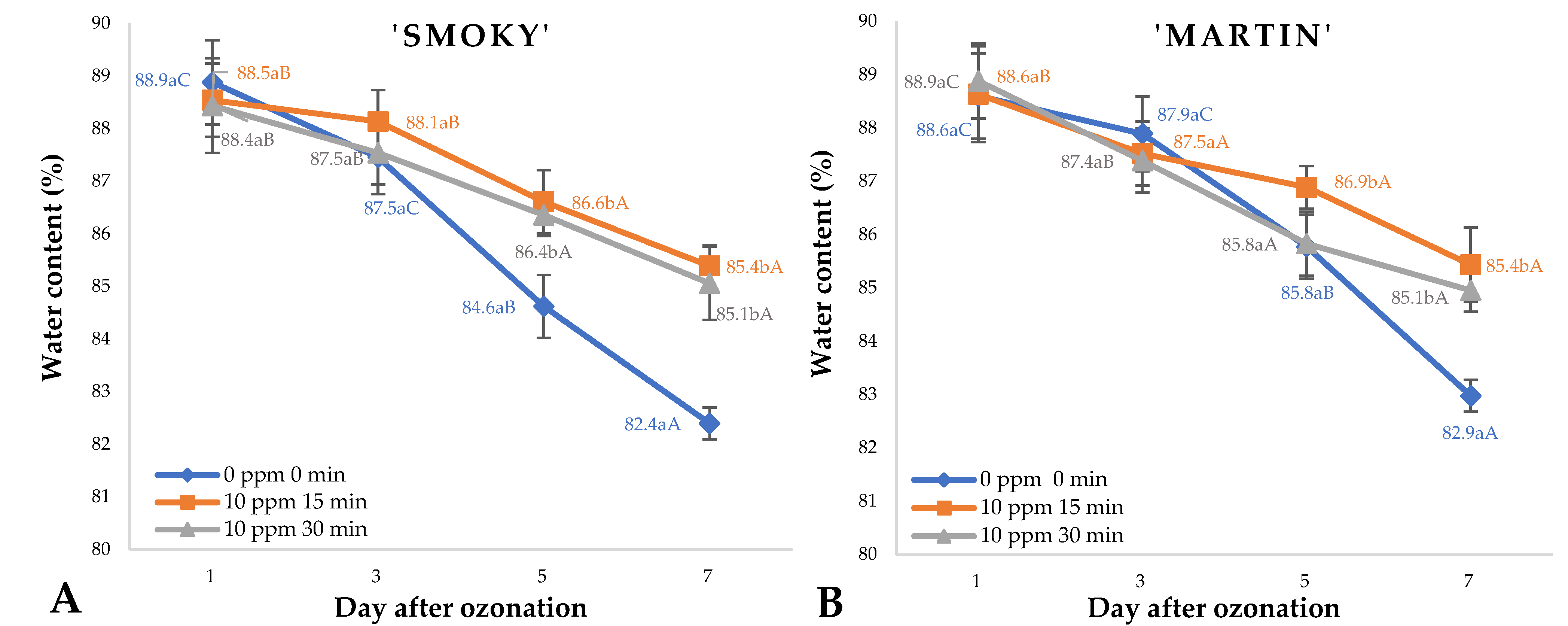
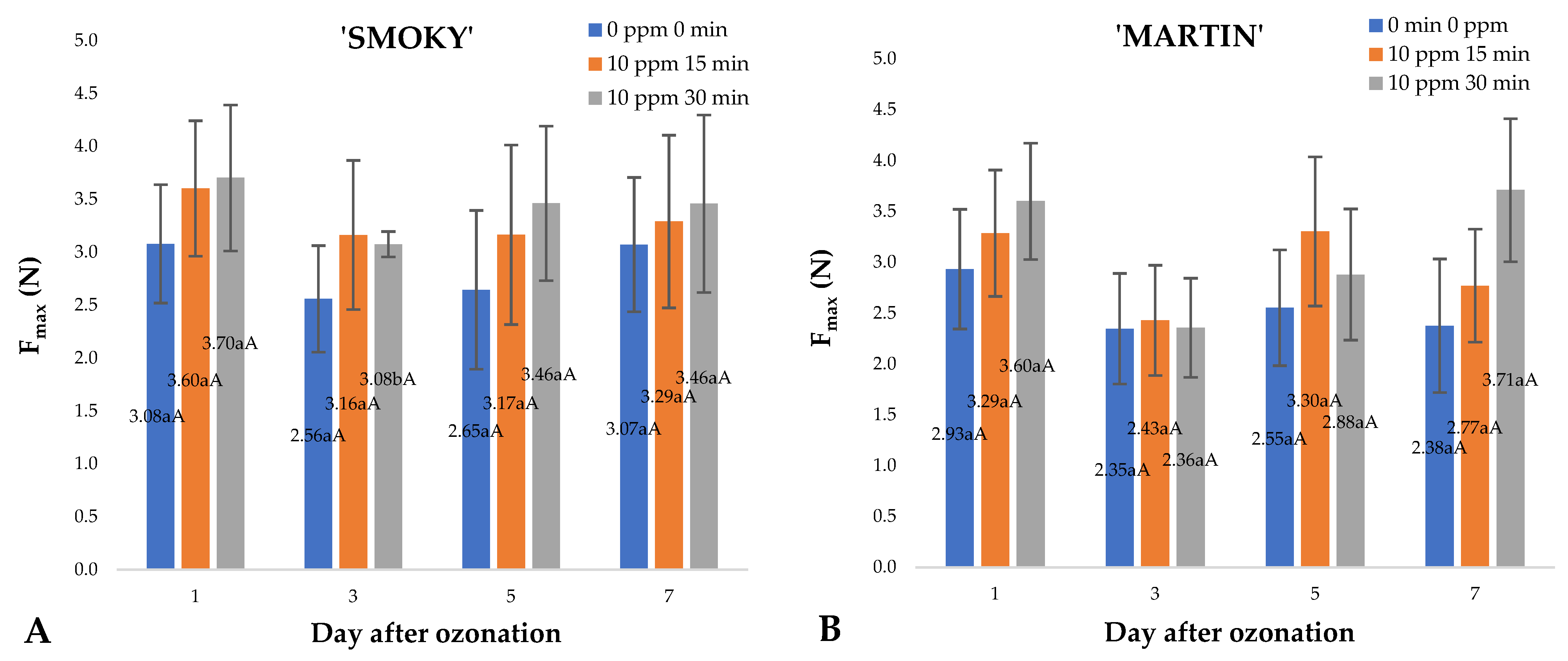
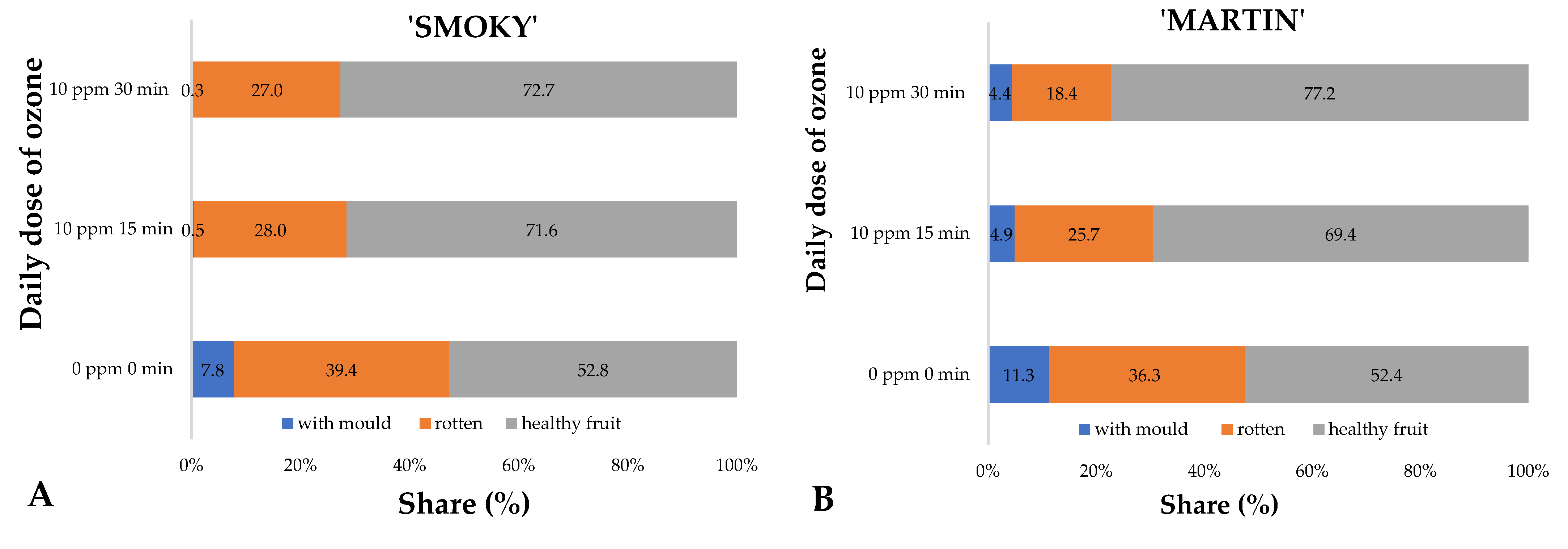
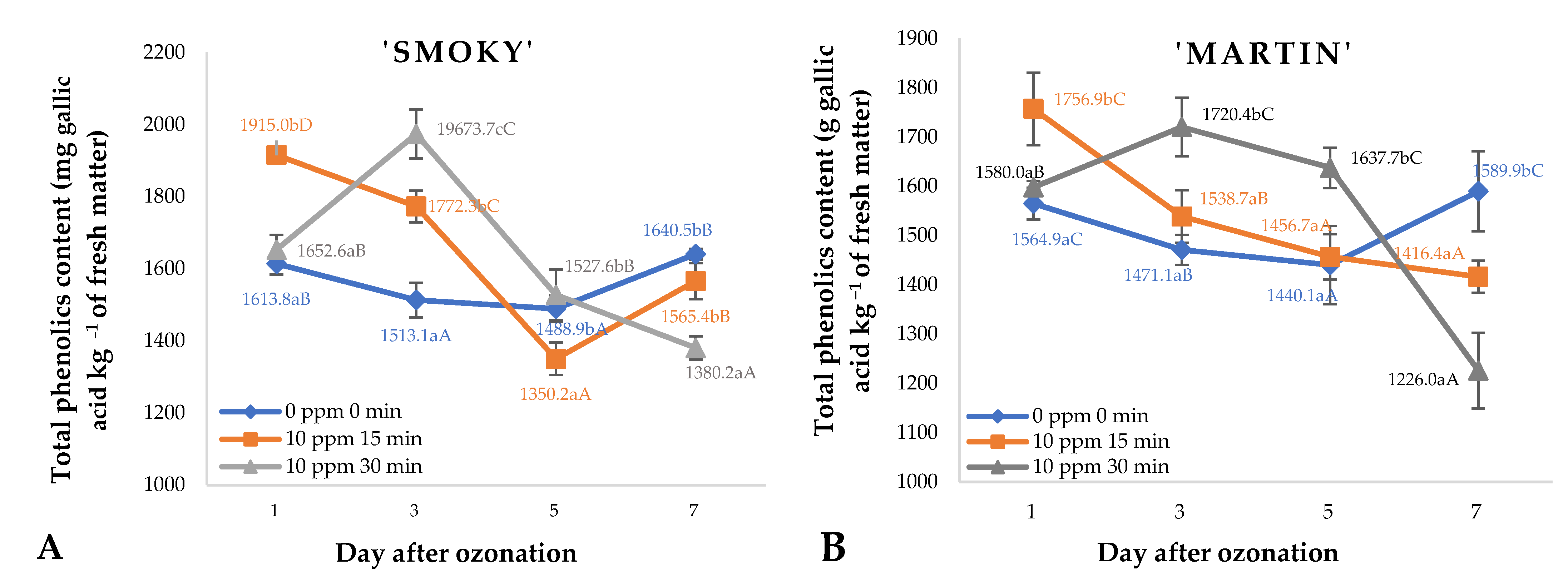
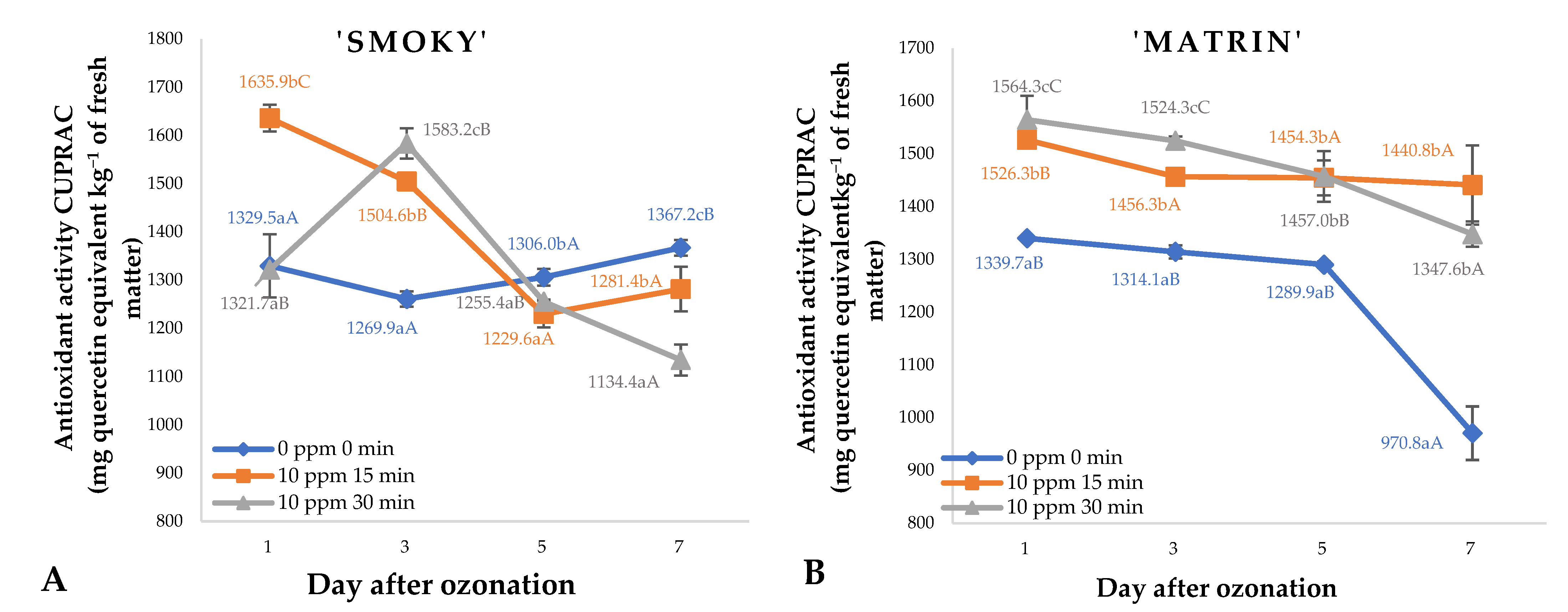
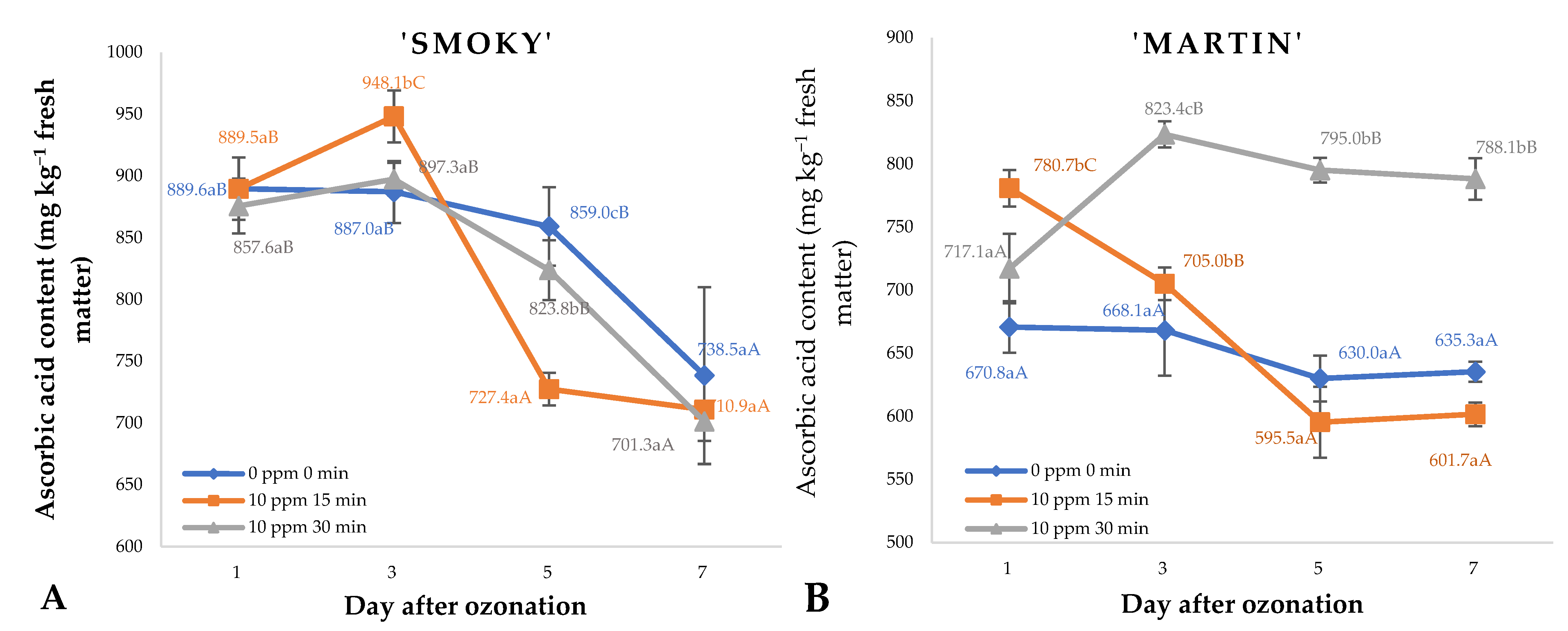
| Date of Measurement | Daily Dose of Ozone | Count of Aerobic Bacteria (log cfu g−1) | Count of Yeast and Mould (log cfu g−1) | |||
|---|---|---|---|---|---|---|
| Cultivar | ‘Matrin’ | ‘Smoky’ | ‘Matrin’ | ‘Smoky’ | ||
| 1 day of ozonation | 0 ppm 0 min | 6.20 aA | 5.40 aA | 3.93 aA | 3.74 aA | |
| 10 ppm 15 min | 6.14 aA | 5.84 aA | 3.58 aA | 3.11a A | ||
| 10 ppm 30 min | 5.46 bA | 5.72 aB | 3.36 aA | 3.00 bA | ||
| 3 days of ozonation | 0 ppm 0 min | 6.49 aA | 5.96 aA | 3.74 aA | 3.88 aA | |
| 10 ppm 15 min | 6.43 aA | 5.81 aA | 3.66 aA | 3.76 aA | ||
| 10 ppm 30 min | 6.28 aB | 5.99 aB | 3.49 aA | 3.66 aA | ||
| 5 days of ozonation | 0 ppm 0 min | 6.26 aA | 5.41 aA | 3.89 aA | 3.93 aA | |
| 10 ppm 15 min | 6.08 aA | 5.11 aA | 3.72 aA | 3.92 aA | ||
| 10 ppm 30 min | 6.06 aB | 5.17 aA | 3.56 aA | 3.60 aA | ||
| 7 days of ozonation | 0 ppm 0 min | 6.32 aA | 5.32 aA | 3.91 aA | 3.97 aA | |
| 10 ppm 15 min | 6.32 aA | 5.34 aA | 3.53 aA | 3.92 aA | ||
| 10 ppm 30 min | 6.26 aB | 5.00 aA | 3.45 aA | 3.59 aA | ||
Publisher’s Note: MDPI stays neutral with regard to jurisdictional claims in published maps and institutional affiliations. |
© 2022 by the authors. Licensee MDPI, Basel, Switzerland. This article is an open access article distributed under the terms and conditions of the Creative Commons Attribution (CC BY) license (https://creativecommons.org/licenses/by/4.0/).
Share and Cite
Matłok, N.; Piechowiak, T.; Zardzewiały, M.; Balawejder, M. Effects of Post-Harvest Ozone Treatment on Some Molecular Stability Markers of Amelanchier alnifolia Nutt. Fruit during Cold Storage. Int. J. Mol. Sci. 2022, 23, 11152. https://doi.org/10.3390/ijms231911152
Matłok N, Piechowiak T, Zardzewiały M, Balawejder M. Effects of Post-Harvest Ozone Treatment on Some Molecular Stability Markers of Amelanchier alnifolia Nutt. Fruit during Cold Storage. International Journal of Molecular Sciences. 2022; 23(19):11152. https://doi.org/10.3390/ijms231911152
Chicago/Turabian StyleMatłok, Natalia, Tomasz Piechowiak, Miłosz Zardzewiały, and Maciej Balawejder. 2022. "Effects of Post-Harvest Ozone Treatment on Some Molecular Stability Markers of Amelanchier alnifolia Nutt. Fruit during Cold Storage" International Journal of Molecular Sciences 23, no. 19: 11152. https://doi.org/10.3390/ijms231911152
APA StyleMatłok, N., Piechowiak, T., Zardzewiały, M., & Balawejder, M. (2022). Effects of Post-Harvest Ozone Treatment on Some Molecular Stability Markers of Amelanchier alnifolia Nutt. Fruit during Cold Storage. International Journal of Molecular Sciences, 23(19), 11152. https://doi.org/10.3390/ijms231911152








